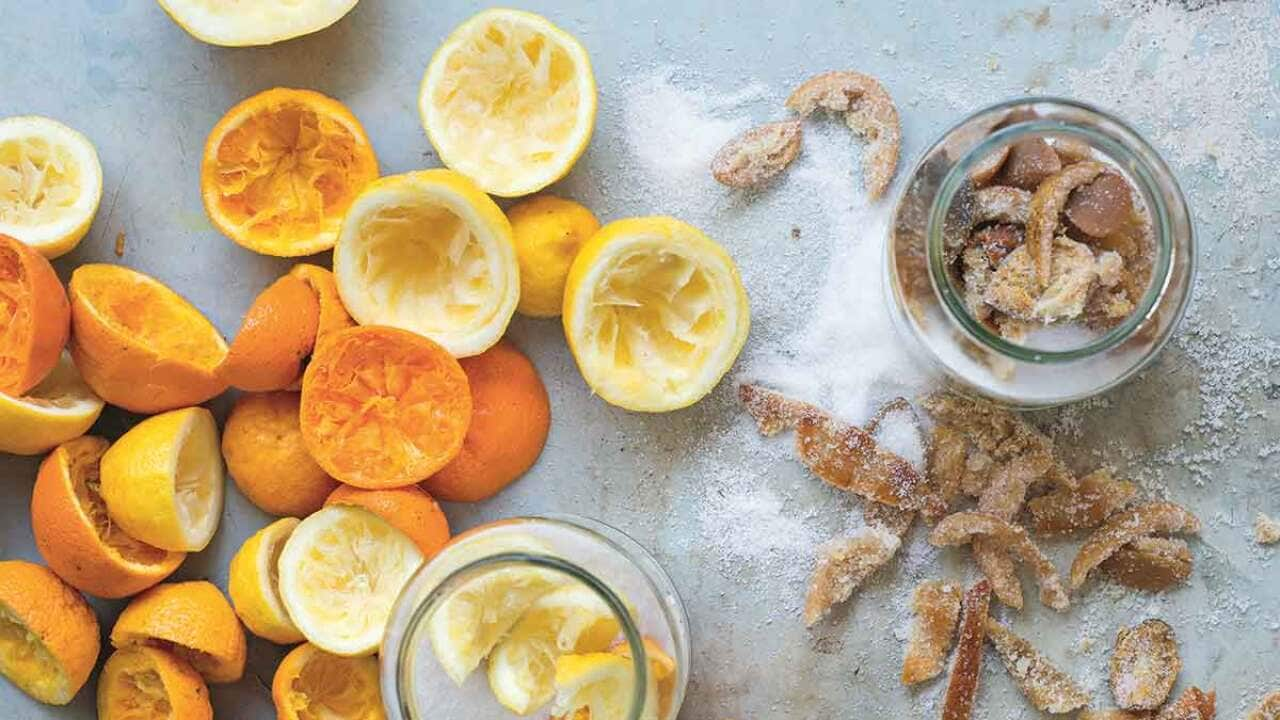makes
1-2 litres
prep
10 minutes
difficulty
Easy
makes
1-2 litres
serves
preparation
10
minutes
difficulty
Easy
level
Everyone is always asking us how to use citrus skins once the fruit has been juiced. This method is similar to preserving lemons, except you’re using 100 per cent salt to preserve the citrus skins, and no citrus juice. And you can combine all different kinds of citrus skins in the one jar – there is no need to preserve them in separate jars.
When a recipe calls for preserved lemons or citrus peel, you can fish a bit of your salt-preserved citrus skin out of the jar, rinse it or soak it for 30 minutes, then thinly slice it to use in stews, soups, tagines, marinades and dressings.
Ingredients
- lots of pure salt or cooking salt
- citrus skins, such as lemon, lime, mandarin or orange
Preserving time: 6 weeks
Instructions
Give your jar and lid a good wash and make sure they are completely dry inside. (If you’d prefer to sterilise them, see Note.)
Put a layer of cooking salt in the bottom of the jar, about 3 cm (1¼ inches) deep. Each time you squeeze a lemon, orange or lime, flatten the peel with the palm of your hand and press it into the salt, then cover the skins with more salt. You can cut the citrus peel into strips to speed up the preserving process – just make sure all the skins are buried under the salt.
As time passes, the salt and citrus peel will compress down and you’ll be able to keep adding more to the jar. The peel will be ready to use after about 6 weeks.
If you’re using a jar with a metal lid, just be mindful that the salt doesn’t reach the top of the jar and corrode the metal.
As the citrus peels release their juices, moisture will start to build up at the bottom of the jar – don’t worry about this, as there is so much salt in the jar that no bacteria will be able to grow.
The jar will happily sit on the benchtop indefinitely, but during a heatwave we like to store it in the fridge.
Note
• To sterilise jars or bottles, give them a wash in hot soapy water and a good rinse, then place upright in a baking dish in a cold oven. Heat the oven to 110°C (225°F) and, once it has reached temperature, leave the jars in the oven for about 10-15 minutes, or until completely dry, then remove them carefully. For hot packing, pour the hot chutney straight into the hot jars; for cold packing, le the jars cool before adding your pickles or preserves.
• To sterilise jars or bottles, give them a wash in hot soapy water and a good rinse, then place upright in a baking dish in a cold oven. Heat the oven to 110°C (225°F) and, once it has reached temperature, leave the jars in the oven for about 10-15 minutes, or until completely dry, then remove them carefully. For hot packing, pour the hot chutney straight into the hot jars; for cold packing, le the jars cool before adding your pickles or preserves.
To sterilise the lids, place them in a large saucepan of boiling water for 5 minutes, then drain and dry with clean paper towels, or leave them on a wire rack to air dry. Make sure they are completely dry before using.
Recipe and Image from by Alex Elliott-Howery and Sabine Spindler (Murdoch Books, RRP $39.99) Photography by Alan Benson.
Cook's Notes
Oven temperatures are for conventional; if using fan-forced (convection), reduce the temperature by 20˚C. | We use Australian tablespoons and cups: 1 teaspoon equals 5 ml; 1 tablespoon equals 20 ml; 1 cup equals 250 ml. | All herbs are fresh (unless specified) and cups are lightly packed. | All vegetables are medium size and peeled, unless specified. | All eggs are 55-60 g, unless specified.
Everyone is always asking us how to use citrus skins once the fruit has been juiced. This method is similar to preserving lemons, except you’re using 100 per cent salt to preserve the citrus skins, and no citrus juice. And you can combine all different kinds of citrus skins in the one jar – there is no need to preserve them in separate jars.
When a recipe calls for preserved lemons or citrus peel, you can fish a bit of your salt-preserved citrus skin out of the jar, rinse it or soak it for 30 minutes, then thinly slice it to use in stews, soups, tagines, marinades and dressings.









